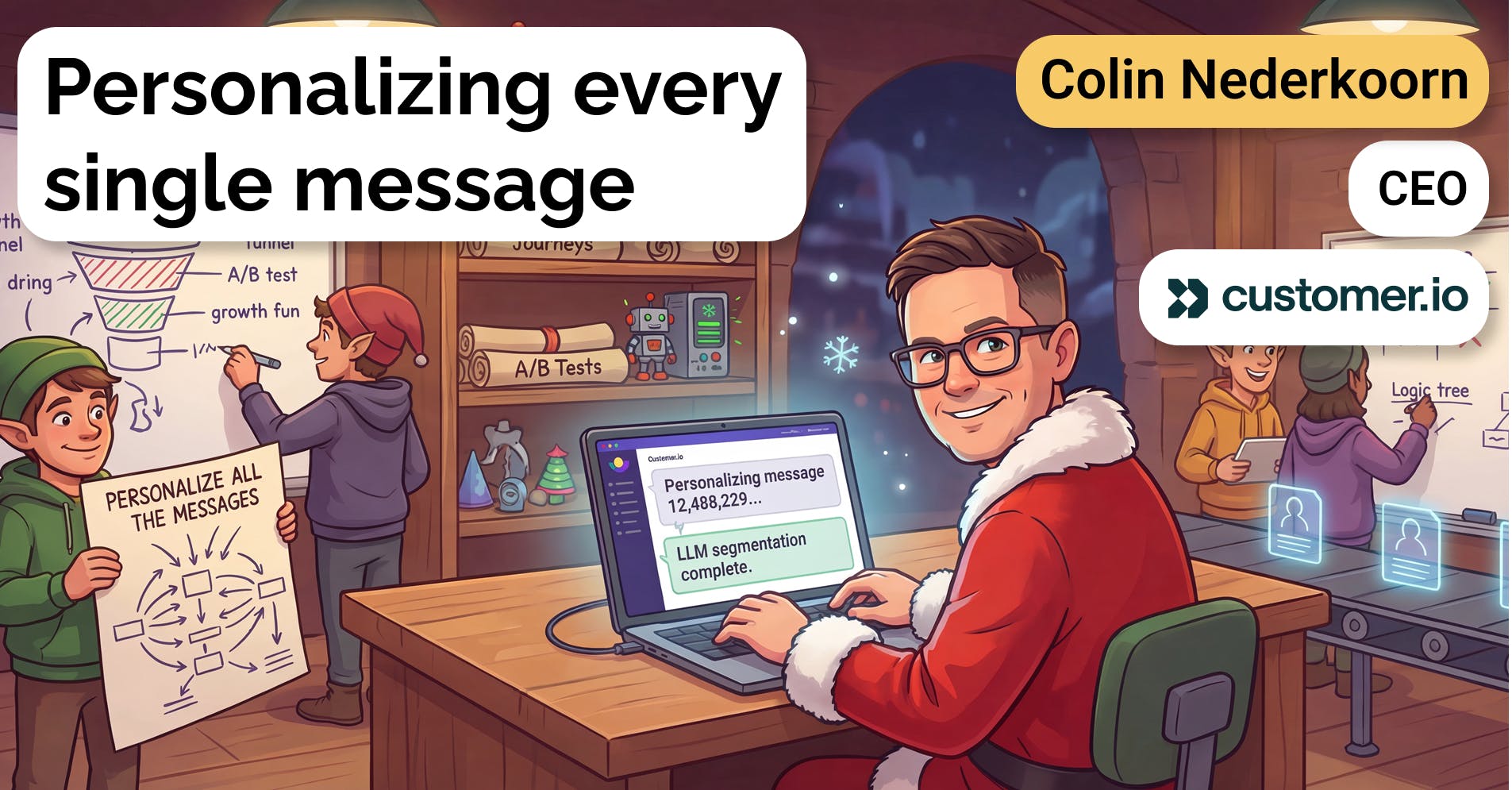Grant Lee, co-founder of Gamma, on rethinking the primitives of presentations
 Jan-Erik Asplund
Jan-Erik Asplund

Background
Grant Lee is the CEO and co-founder of Gamma. We talked to Grant to learn more about how visual communication tools like slides, images and videos are becoming essential for sales & marketing, product, HR and potentially everyone in an organization—and how Canva, Figma, Microsoft Office and Google Suite and others are trying to build the 'creative productivity' suite that stitches them all together.
Questions
- Big picture, how do you think about the history of slides, and what made you excited enough about the format to devote your time to it at Gamma?
- You mentioned that one of the biggest timesucks here is the design and formatting aspect of slides, but you also seem to be saying that companies that are just building beautified versions of Google Slides are missing the point. Is there some kind of fundamentally different primitive that’s needed that departs from Google Sheets? How do you think about that?
- In terms of how folks use slides and presentations in general, do you see any difference between internal communications versus various external use cases?
- Does it make sense to talk about these as two different kinds of products entirely, since the use cases and the contexts are so different? Has that influenced your product thinking at Gamma at all?
- I’d love to get your take on design tools like Canva and Figma. One of our theses has been that Canva and Figma both want to get wall-to-wall adoption inside companies, and part of that maybe involves functionality around slides. I know some people make slides in Figma. How do you think about the opportunity for taking a design approach to slides?
- You shed some light on horizontal tools like PowerPoint and Slides, where it's actually powerful to be part of a bundle because you do have access to other tools. But despite this advantage, what kinds of trends are you seeing that make PowerPoint and Slides less effective over time at solving the key jobs to be done around slides and presentations?
- You’ve mentioned Notion and Airtable. I'm curious if you have thoughts on how those companies specifically were able to take on free and bundled software, like Sheets and Docs, and build sustainable standalone businesses. How do you think about what made that a successful play?
- How do you at Gamma think about what a set of primitives might be for the 21st century presentation?
- Is there a bias towards internal or external use cases at all with Gamma?
- If you’re PowerPoint, then you already have quick access to other files that the go-to-market team might need. Do you have an idea in mind for how to get into that ecosystem and that flow of documents, such that it can be as easy to get that into Gamma as it is today from other tools that people are using?
- For your beta testers now, what does the profile look like? Are there specific kinds of personas who would use Gamma?
Interview
Big picture, how do you think about the history of slides, and what made you excited enough about the format to devote your time to it at Gamma?
For me, using slides goes way back. I remember using them in high school for all of our class presentations. Even then it was kind of the same thing: slides used as a sort of visual aid. You're presenting in front of a classroom -- or eventually presenting to your colleagues in a meeting -- and you're using that to guide your talk track. Certainly there are also use cases where you're up on stage giving a keynote address, and even more so in that case the slides are really a visual aid.
But if you look at how slides get used in the workplace today, it's really much more as a communication tool. The medium gets used to share ideas, collaborate, go back and forth a bunch. What ends up happening is a lot of people try to cram all of their thinking into a slide deck, then have to think about, “Are these slides going to be read, or are they going to be presented live, or are they going to be both? What happens when I, as the presenter or the creator, am not there? I need to make sure that they still work.”
After spending a lot of time looking at how slide decks get created today, we realized that so much of our time ends up being spent on just formatting the content rather than on the content itself. When you think about the most powerful tools out there today -- and this is obviously over the past couple decades -- PowerPoint is still by far the most powerful and versatile tool. You have tools like Keynote, which is the most beautiful out there when you really want to create something that catches people's eyes, attention and their imagination. And then of course tools like Google Slides, which has been around for a while now, integrate real time collaboration. Then there's a long tail of startups that have come along that have been trying essentially to create incrementally better slideware -- tools like Pitch that have made a more beautiful version of Google Slides, and Beautiful.ai, which is attempting to offer more auto-formatting within slides. And then there's a bunch that have died along the way, like Projector, which was making slides for different formats.
So for me, what it came down to at Gamma is, we're not trying to create an incrementally better slideware tool. What we are really trying to ask is, what would slide decks look like if we were really optimizing for communication and content, and could somehow eliminate all the work needed to format something to make it look nice or professional.
We almost think of slides as being born in a different era of work, which we call internally the “print and project” era of work, where everything needed to be printed on a piece of paper or projected on a screen. Back in my banking days, I was the one at midnight binding these books so that the managing directors could flip through these pieces of paper, mark all their edits on the piece of paper, and hand them back to me. So everything obviously needed to fit on that piece of paper, and then you'd bind them for your clients, and so on and so forth. Then there was also this projector era of work, where, when we were in meetings, we all had to be sitting in the same room, staring at the same screen, looking at a presentation.
Obviously COVID rapidly accelerated our shift away from this era of work. It shifted us to this new paradigm of hybrid work. I think hybrid work is actually two big buckets of things. One is much more async work. When you think about hybrid work, you think about distributed teams, and with distributed teams, many teams are not in the same time zone, so you're working around the clock.
Then the other thing is virtual work. Even as people start returning into the office, you're likely going to have a subset of people that are always on Zoom. If that's the case, then everybody has their own device in front of them -- their own laptop, computer, maybe phone. We're missing a big opportunity -- when the device is in front of you versus us staring at a shared screen -- for us to be able to interact with this content in real time. The ability to interact with things is a major unlock that wasn't really possible when one person used to be operating their laptop and projecting onto a screen.
So all these things -- realizing that there's a massive opportunity where how we work today has dramatically shifted how this medium that has been used universally across companies of all sizes to communicate, share ideas and bounce things back and forth, could look like -- is what got us excited about Gamma.
You mentioned that one of the biggest timesucks here is the design and formatting aspect of slides, but you also seem to be saying that companies that are just building beautified versions of Google Slides are missing the point. Is there some kind of fundamentally different primitive that’s needed that departs from Google Sheets? How do you think about that?
Totally. I think there's a set of primitives. The underlying thing is that, with all slideware, you're given a fixed canvas, and that canvas is aligned with something that needs to fit on a piece of paper. Because, again, in the old paradigm, if you create a slide, you need to be able to print it on a sheet of paper.
How do you fit your ideas -- the very complex thing you want to walk through -- onto one sheet of paper? You either basically try to water down all your ideas and do these very punchy bullet points, so that if I'm in the room, I'm presenting to you, I know what the bullet point is and I'm going to talk you through it. Or you have a hundred slides, where every single slide has maybe one little sliver of the main thing. Then you need to walk linearly through the entire set of slides to be able to tell the entire story.
So the primitive is really one that’s stuck in a constraint that existed in the past, because that's how things needed to be done. You needed to be able to have something printed, versus if we think ten years into the future -- how many decks are going to need to be printed on a piece of paper, and how many meetings are there going to be where everyone's staring at the same screen to look at a presentation instead of being on their own device? If we remove that as a constraint, the primitives you have open to you become much more interesting.
In terms of how folks use slides and presentations in general, do you see any difference between internal communications versus various external use cases?
Internally, slides are often used as a form of collaboration. A lot of it is used to help run a meeting, run a project, recap takeaways or summarize things. Oftentimes you'll have management being the spearhead in terms of creating what template is used broadly within an organization, and they're the ones that are presenting most often and sharing out a lot of that information.
I think what has changed a lot is the real time collaboration piece. Pre-Google Slides there wasn't much of that. You would just have someone presenting one time, and there wasn't a lot of, “Let's all add comments into a doc or a slide deck.” I think that's happening much more today.
Externally, you don't have any of that. You don't have any of the, “Oh, provide me feedback and leave me a comment.” I think of it as maybe two buckets for external. One is the go-to-market motion, so using it as sales and marketing collateral. In that case, you're oftentimes basically creating just an extension of the rest of your marketing materials. You're sending that off to a client, and you often need to be able to essentially achieve, in that case, the lowest common denominator, which is every single client needs to be able to consume this content that often defaults back to PDF. A client says, “Oh, PDF me a copy.” That's where traditional tools do work well, because you can just PDF a copy of your Google Slides or PowerPoint, and send that off. You're not commenting in Google Slides or on PowerPoint. You often get that feedback back, either in person, virtually or in an email where the client will respond. A lot of the collaboration happens outside of the medium itself.
Then the other external bucket is the more episodic one-to-many keynote address or fundraising pitch deck, where there is less need for collaboration compared to internal use cases. It's more of a way to convey your thinking and capture that in a set of slides that others can consume in that way.
Does it make sense to talk about these as two different kinds of products entirely, since the use cases and the contexts are so different? Has that influenced your product thinking at Gamma at all?
Obviously, PowerPoint is used in so many different ways. At the end of the day, it's a tool for capturing content, and it’s also a visual design tool in many cases, so people use it as they will.
I think there's just so much overlap in any one of these tools, similar to Notion and a lot of the new era doc-like tools, and Airtable. You can look at their use cases, and they're very broad and expansive. I think people end up tailoring them for their own use cases, if the building blocks they have are useful enough for them.
I’d love to get your take on design tools like Canva and Figma. One of our theses has been that Canva and Figma both want to get wall-to-wall adoption inside companies, and part of that maybe involves functionality around slides. I know some people make slides in Figma. How do you think about the opportunity for taking a design approach to slides?
My own point of view is that both those tools are design tools. They're visual. In both cases, I think they’re essentially trying to democratize visual design and make it much easier for people that are getting into design to have something that doesn't immediately feel overwhelming like a power tool -- it could be something that they can step into over time and get better at. There's a low enough floor such that they can get going, but certainly still a high ceiling when they do want to flex their muscles a bit -- I think Figma probably more so on the high ceiling. But they’re design tools.
I think the challenge for them to go wall-to-wall is that, by being a vertical tool, by design, you're limiting the functionality needed to be optimized for that particular persona. Things that you start ignoring are things like, how do you play well with other tools. If you're building a horizontal tool, you almost immediately need to start thinking about, “Okay, one of the most common use cases for slides is presenting data. So we need to be able to not only throw in text and images, but what if I want to embed a chart or table from Google Sheets?”
When you're not thinking about those sorts of tools, then you're immediately closing off that use case. And there's a whole slew of integrations, APIs, partnerships that you'll probably need to think about it if that's truly the direction we want to go, versus designers, who oftentimes don't care -- like, “I don't need to integrate with my BI platform. That has nothing to do with the work I do. I just want to be able to create better drop shadows.” There's a whole slew of things they want on their wish list.
So I think the main opportunity for Figma and Canva is just the rise of designers in general. I think there are going to be more and more design needs. Whether it's for marketing purposes or product purposes, there's just a growing need for well-designed products and experiences, and tools like Figma and Canva are certainly going to play a huge role in that. Now, to go wall-to-wall and say, “Okay, we're also going to serve the finance team when they create a board deck.” I find that much more challenging, because there's a long tail of things that they'll have to get -- not least of which is the collaboration piece -- that make it challenging.
Related to that, when you are a design tool, the most fundamental thing around organizational hierarchy and search, for instance, is that you're searching for digital assets within your paradigm, your platform. Versus a horizontal tool or a more content-driven tool like Slides or Docs, where you're searching for individual files or individual pieces of content -- I need to be able to find my board deck from 2019, or I need to be able to find my all-hands presentation. When your search paradigm is around design templates and assets and “I need to find this particular piece of marketing collateral” versus “I need to find this file that has this content in it,” you end up optimizing for very dramatically different things.
I think that's where the challenge will be. It sounds like it might be easy to do wall-to-wall once you have some adoption, but I imagine the challenge is that it's actually a very dramatically different use case.
You shed some light on horizontal tools like PowerPoint and Slides, where it's actually powerful to be part of a bundle because you do have access to other tools. But despite this advantage, what kinds of trends are you seeing that make PowerPoint and Slides less effective over time at solving the key jobs to be done around slides and presentations?
I think a lot of it goes back to this shift to more hybrid or remote work. After interviewing a ton of founders that have either been remote-first from the beginning or are shifting to remote-first, I found that one of the most important things is this default to async work, where documentation is just so critical. Everything needs to be well documented, shareable and discoverable within your team.
Being able to find that old content, build on content and remix content I think is key. It’s so important, and slides just weren’t built for that. They were built for being a visual aid. When you have all these slides that are becoming walls of text -- tons of text -- and you can't even easily search within a slide deck for that content, it just ends up being a silly way to communicate.
So then I see founders lean on tools like Notion, which is great for a lot of that, because you can document everything. There is an organizational hierarchy built around blocks of content, so it becomes a lot easier to have some material or content that could be evergreen and that could be used to ramp up all your different employees or onboard customers -- places to point people.
I think that's where there will be a wave of these tools that displace use cases that slides have been hacked together to serve. In a less hybrid world, it worked decently well; in a very hybrid or remote-first world, it is not going to work nearly as well.
You’ve mentioned Notion and Airtable. I'm curious if you have thoughts on how those companies specifically were able to take on free and bundled software, like Sheets and Docs, and build sustainable standalone businesses. How do you think about what made that a successful play?
I think it's different for both Notion and Airtable. For Notion, I think a lot of their early adoption was around individuals just gravitating towards something different, and there's a new set of building blocks that you can play with that isn't available in Google Docs.
But more importantly, they have a really powerful organizational hierarchy. When you think about their tree structure to the left -- and I think people have been complaining forever about how with Google Drive and Google Docs, you can't find anything, it's hard to organize, creating folders is painful -- they've really nailed it with something that is intuitive enough, where people that gravitate towards Notion’s way of writing are like, “Okay, all of a sudden I can create a really powerful system, even if it's just for myself to be able to organize all of my thinking and all of my work, and it all eventually can be interlinked.” You no longer have 50 different tabs open with individual Google Docs and Google Sheets. It's essentially all-in-one: all the things you might have done in a Google Sheet to track certain things and a Google Doc to write up things can be combined into one tool. I think people just love the ability not to have to waste time sifting through the noise in GDrive. And, of course, being free in the beginning for initial users was a great way to get adoption.
How do you at Gamma think about what a set of primitives might be for the 21st century presentation?
With Airtable, I think it's slightly different. I think most of their power is around automation and workflows. It's really about: if you understand how to get a base set up, then basically you can save yourself so much time. All this time that in the past used to be wasted in terms of getting all the content and organizing it -- it's all done for you. And it's highly usable. You just spend a little bit more time upfront, but you save a ton of time once the automation is set up.
For us, at Gamma, we use it to collect all of our signups. When someone signs up for an account for beta access or we have survey responses -- all that's easily captured. We throw that into one place. Our team can then go through it, and mine it for helpful insights or segment users based on the use case, so that we can bundle that up in terms of how we might get user feedback and user research. It’s just so easy, whereas trying to track that in a spreadsheet or set of spreadsheets would be impossible or very cumbersome. They've really nailed the automation piece.
A lot of what we're focused on today I guess goes back to my point earlier: what if you could remove the constraint of everything having to fit on a piece of paper, and you have a screen in front of you? What if you could package up content in different ways and lean on this concept of disclosure? So, only when you want to be able to access something do you open it up. That's when it opens up full screen; otherwise it's tucked away, and it's small. It doesn't become this wall of text when you have all these different things.
Is there a bias towards internal or external use cases at all with Gamma?
So our primitive is this concept of a card. A card can be any length and any height. You've released the constraint of it being fixed. And in addition to that, a card can hold anything. It can fit text and images, but you could also embed multimedia. It supports video -- you could record a Loom directly into a card. You could provide voiceover or a screen recording. If you're doing a demo, you could embed any other website or web app. If your presentation is on, “Hey, actually want to walk you through all of the signups we have in Airtable” -- I'll just embed the Airtable base, and I'll show you all that stuff live, directly in Gamma, and then still be able to provide context around what you are actually looking at.
You are no longer constrained by either the dimensions of what you're fitting or what you can actually put onto a slide. There's so much we can do in both directions that, over time, hopefully it becomes this interesting medium where, no matter what you want to share, present, or even consume as a reader, you'll be able to do that. And it'll all be in the same medium.
If you’re PowerPoint, then you already have quick access to other files that the go-to-market team might need. Do you have an idea in mind for how to get into that ecosystem and that flow of documents, such that it can be as easy to get that into Gamma as it is today from other tools that people are using?
For us, at least in terms of sequencing, we're thinking about internal being an easier beachhead, because it’s relatively lower stakes and collaboration is key. When you want to be able to collaborate in real time, you can do all that in Gamma. For external, when collaboration isn't as important, you really need to be able to lean on something that you trust. If all your other marketing collateral is already built in Canva or PowerPoint, it's much easier just to lean on that, because you have the assets all in one place.
The thing with go-to-market teams is they do have much higher willingness to pay, so we do want to be able to go into that direction eventually. But we're sequencing it differently, such that we're optimizing for getting much stickier internal adoption first, and then hopefully earning the right to extend beyond that and go external.
There's a lot of different things we'll be exploring. One of the things for internal specifically is just being able to import existing content and convert that into Gamma. That’s a relatively simple way to just get some initial adoption. If you have a bunch of content already created on Google Docs or even Google Slides, can we automatically convert that into our format, such that you can enjoy the flexibility that our format provides that you can't get elsewhere.
Then longer term -- especially around more go-to-market or external use cases, where digital assets and things like that are going to matter -- we will probably have to consider being our own content repository. So if you do have assets that can be maintained within Gamma, we’d enable having those be searchable, reusable, and maybe synced across multiple Gammas. But it's not an obvious short list of things. I think there are a lot of things we'll have to explore.
For your beta testers now, what does the profile look like? Are there specific kinds of personas who would use Gamma?
With our sign-ups, we've gotten a pretty broad swath of interest. Slides are pretty pervasive across all different business units, but for us, we've seen a lot of interest from folks like product managers, where a lot of their work today is taking a PRD, which is a doc, and synthesizing and converting that into slides anytime they need to present it. And they're always presenting to different audiences. So they need to create a version for management, a version for engineering, a version for other internal stakeholder buy-in, maybe a version for customers to get initial feedback. It ends up being so much time translating back and forth. A lot of what product managers are interested in doing is: can they replace two tools and just have it all live in Gamma? So that, no matter whom you're presenting to, you can actually package it up in a way where you can figure out at what elevation to present that information and use the same material for both use cases. That's been interesting.
I think the other is around go-to-markets or product marketing managers, creating sales leave behinds or pitch decks useful for sales teams. Then related to that, a different type of selling -- fundraising, when founders are trying to create their investment memos. I've seen tons of examples where it’s done in Notion or tools that are much more doc-heavy, but then they all end up looking kind of the same. And then the question is, are people even reading this? Is this engaging enough? When things do feel like a wall of text, or just something that looks exactly the same as every other investment memo, it becomes less appealing. So founders are gravitating towards something that gives them the flexibility to express themselves, while also packaging up the important information they need and making it shareable and obviously collaborative when needed with external parties.
Disclaimers
This transcript is for information purposes only and does not constitute advice of any type or trade recommendation and should not form the basis of any investment decision. Sacra accepts no liability for the transcript or for any errors, omissions or inaccuracies in respect of it. The views of the experts expressed in the transcript are those of the experts and they are not endorsed by, nor do they represent the opinion of Sacra. Sacra reserves all copyright, intellectual property rights in the transcript. Any modification, copying, displaying, distributing, transmitting, publishing, licensing, creating derivative works from, or selling any transcript is strictly prohibited.










